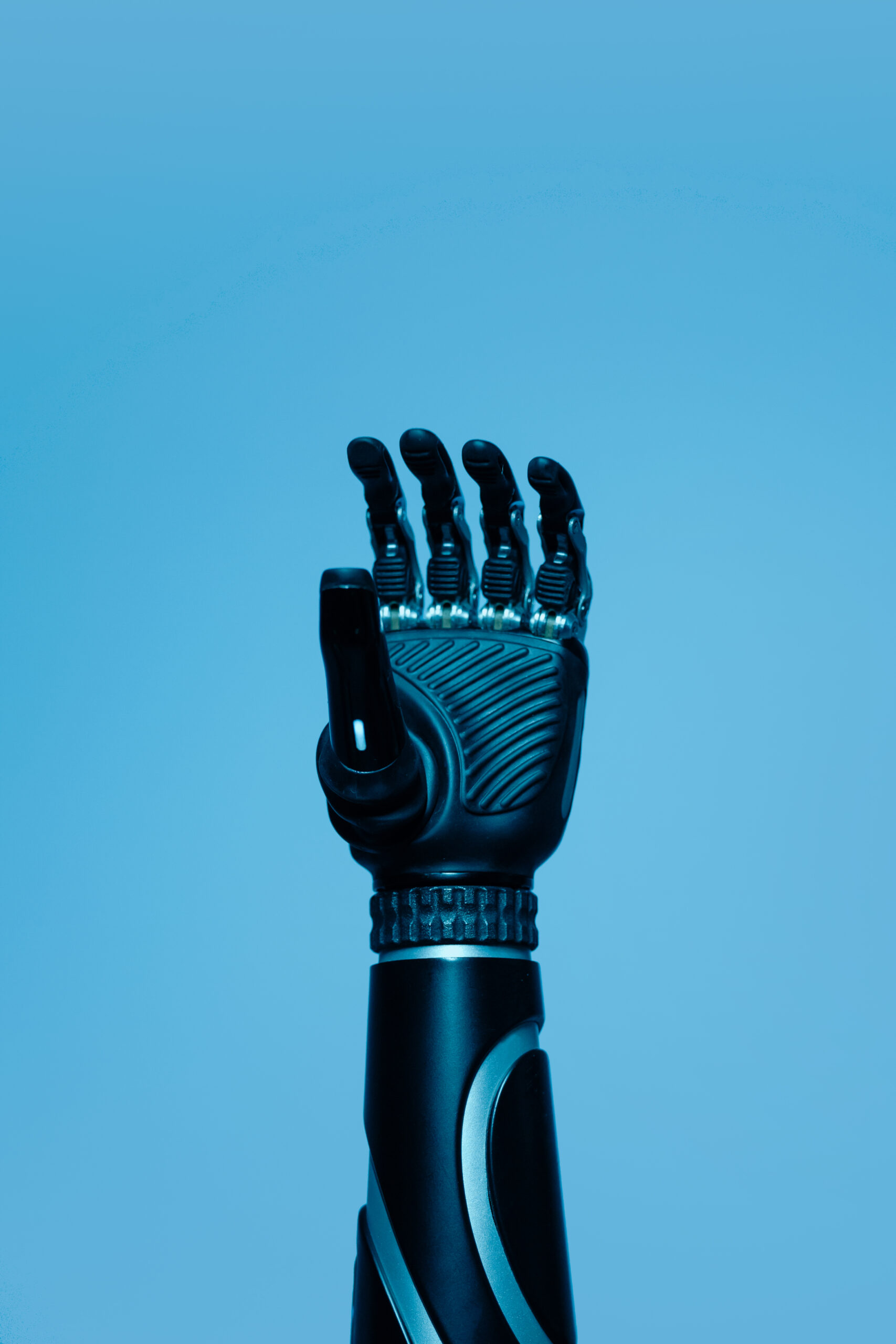Imagine a future where amputees can regain not only the physicality of their lost limbs but also the sensation and touch that was once taken for granted. Thanks to groundbreaking advancements in prosthetics, bionic limbs with sensory feedback are emerging as the future of the field, offering the promise of a more seamless integration between man and machine. By incorporating technology that allows users to feel the texture, temperature, and pressure of objects, these bionic limbs have the potential to revolutionize the lives of amputees and redefine what it means to live with a prosthetic limb.
Understanding Bionic Limbs
Concept of Bionic Limbs
Bionic limbs, also known as prosthetic limbs, are artificial devices that are designed to replace or augment missing or impaired body parts. These advanced technological marvels are revolutionizing the field of prosthetics, providing individuals with the opportunity to regain lost functionality and lead more fulfilling lives.
The concept behind bionic limbs is to create a seamless integration between human anatomy and robotic technology. By utilizing state-of-the-art electronics, robotics, and sensory feedback systems, engineers and scientists can replicate the intricate movements and sensations of natural limbs, translating neural signals into motion and touch.
Types of Bionic Limbs
There are various types of bionic limbs, each designed to cater to specific amputation levels and functional requirements. Some common types include:
-
Upper Limb Prosthetics: These bionic limbs replace lost or impaired arms, hands, and fingers. They can restore functions like gripping, grasping, and manipulating objects with dexterity.
-
Lower Limb Prosthetics: Lower limb bionic limbs are designed to replace missing or non-functioning legs and feet. They enable individuals to walk, climb stairs, and engage in physical activities with greater ease and mobility.
-
Partial Hand Prosthetics: These specialized prosthetics are designed for individuals with partial hand amputations. They restore the functionality of fingers and thumb, allowing for intricate movements like picking up small objects.
Components of Bionic Limbs
Bionic limbs consist of several essential components that work together to provide natural movement and sensory feedback. These components include:
-
Socket Interface: The socket interface is the connection between the residual limb and the prosthetic limb. It ensures a secure and comfortable fit, allowing for efficient transfer of movements and forces.
-
Actuators and Motors: Actuators and motors are the driving force behind the movements of bionic limbs. They convert electrical signals into mechanical motion, replicating the natural range of movements.
-
Sensors: Sensors are an integral part of bionic limbs as they provide crucial feedback to the user and the prosthetic control system. These sensors detect and measure forces, position, and speed, enabling the limb to adapt to various environments and tasks.
-
Microprocessors and Control Systems: Microprocessors and control systems are like the brains of bionic limbs. They process sensor data and convert it into precise movements, ensuring smooth and coordinated motions.
-
Power Source: Bionic limbs require a power source to function. This can be in the form of rechargeable batteries or external power supplies, depending on the type of prosthetic limb and the user’s preference.
Revolution in Prosthetics: Sensory Feedback
What is Sensory Feedback?
Sensory feedback refers to the ability to perceive and interpret information from the environment through the senses. In the context of bionic limbs, sensory feedback plays a vital role in providing users with a realistic and immersive experience. It allows them to perceive touch, temperature, and pressure, just like they would with their natural limbs.
Sensory feedback can be categorized into two main types: tactile feedback and proprioceptive feedback. Tactile feedback relates to the sense of touch and includes sensations such as pressure, texture, and vibration. Proprioceptive feedback, on the other hand, pertains to the sense of position and movement of our body parts.
Importance of Sensory Feedback in Prosthetics
Sensory feedback in prosthetics is crucial for several reasons. Firstly, it helps users better control their bionic limbs, resulting in more natural and coordinated movements. Additionally, sensory feedback allows users to regain a sense of touch, which is essential for object manipulation, fine motor skills, and overall limb awareness.
Furthermore, sensory feedback plays a significant role in reducing the cognitive load on users. By receiving real-time feedback from their bionic limbs, individuals can rely less on visual cues, freeing up cognitive resources for other tasks and activities.

Technology Behind Bionic Limbs with Sensory Feedback
Integration of Electronics with Biology
The technology behind bionic limbs with sensory feedback involves a complex integration of electronics and biology. Engineers and scientists work tirelessly to bridge the gap between the human nervous system and artificial prosthetics, creating a seamless interface for communication.
One of the key advancements in this field is the development of neural interfaces. These interfaces consist of electrodes or sensors that are implanted directly into the nerves or muscles of the residual limb. By detecting and interpreting neural signals, these interfaces can translate the user’s intentions into precise movements and sensations.
Additionally, advances in bioengineering have allowed researchers to develop biocompatible materials that can seamlessly integrate with biological tissues. These materials promote better signal transfer between the nerves and prosthetic components, enhancing the overall performance and functionality of bionic limbs.
Role of Robotics in Bionic Limbs
Robotics plays a crucial role in the development and functionality of bionic limbs. Robotic technology enables precise and coordinated movements, allowing for greater control and naturalness in the user’s interactions with the prosthetic limb.
Through the use of artificial intelligence and machine learning algorithms, bionic limbs can adapt and learn from the user’s movements over time. This adaptive nature enhances user experience and functionality, enabling individuals to perform complex tasks with relative ease.
Robotics also facilitates the incorporation of sensory feedback systems into bionic limbs. By combining sensors, actuators, and microprocessors, engineers can create a closed-loop system that continuously monitors and adjusts the prosthetic limb’s movements and responses based on the user’s sensory inputs.
The Process of Bionic Prosthetics
Creating a Bionic Limb with Sensory Feedback
Creating a bionic limb with sensory feedback involves a multi-step process that requires collaboration between medical professionals, engineers, and prosthetists. The process typically includes:
-
Assessment: The first step in creating a bionic limb is the assessment of the user’s needs and functional requirements. This evaluation considers factors such as the level of amputation, residual limb condition, and desired functionality.
-
Socket Design and Fitting: Once the assessment is complete, a custom socket is designed and manufactured to ensure a secure and comfortable fit between the residual limb and the prosthetic limb. This step is crucial for efficient movement transfer and comfort.
-
Component Selection: Based on the user’s needs, the appropriate components such as sensors, actuators, and microprocessors are selected. These components are chosen to cater to the user’s functional requirements and optimize sensory feedback.
-
Implantation of Neural Interfaces: In cases where neural interfaces are used, surgical implantation of these interfaces is carried out. This procedure involves the precise placement of electrodes or sensors into the nerves or muscles of the residual limb.
-
Calibration and Programming: Once all the components are in place, the bionic limb is calibrated and programmed to ensure optimal functionality. This step involves configuring the limb’s movements, sensitivity, and sensory feedback settings according to the user’s preferences and abilities.
How does a Bionic Limb with Sensory Feedback Work?
A bionic limb with sensory feedback works through a combination of sophisticated electronics, robotics, and neural interfaces. The limb is equipped with sensors that detect various environmental stimuli, such as pressure, temperature, and texture. These sensory inputs are then converted into electrical signals, which are sent to the control system.
The control system, typically a microprocessor, processes the sensory inputs and generates corresponding motor commands. These motor commands are transmitted to the actuators and motors of the prosthetic limb, resulting in precise and coordinated movements.
Simultaneously, when the user interacts with objects or surfaces, the bionic limb’s sensors detect changes in pressure or forces. This information is transmitted back to the control system, which then generates tactile feedback in the form of vibrations or pressure on the user’s residual limb.
The integration of sensory feedback completes the loop, allowing users to perceive touch and pressure feedback as if they were using their natural limbs. This seamless interaction between the user and the bionic limb enhances functionality and restores a sense of normalcy.

Benefits of Bionic Limbs with Sensory Feedback
For the Amputees
Bionic limbs with sensory feedback offer numerous benefits to individuals living with limb loss. These benefits include:
-
Restored Functionality: Bionic limbs enable users to perform daily tasks and activities that would otherwise be challenging or impossible. With increased control and natural movements, individuals can regain their independence and participate more fully in their daily lives.
-
Improved Body Awareness: Sensory feedback allows users to regain a sense of limb position and orientation. This heightened body awareness facilitates better coordination and balance, reducing the risk of falls and injuries.
-
Enhanced Object Manipulation: Tactile feedback enables individuals to grasp objects with varying levels of force, improving their ability to handle delicate or fragile items. This level of control and precision is crucial for tasks like writing, typing, cooking, and many others.
Effects on the Quality of Life
The impact of bionic limbs with sensory feedback on an individual’s quality of life is significant. These advanced prosthetics offer:
-
Psychological Benefits: Bionic limbs can boost self-confidence and self-esteem by restoring an individual’s physical appearance and functionality. The ability to perform tasks and interact with the environment more naturally can greatly improve one’s mental well-being.
-
Social Integration: The improved functionality provided by bionic limbs allows individuals to actively participate in social activities and engage with others. This integration can lead to an increased sense of belonging and a better overall quality of life.
-
Improved Emotional Well-being: Regaining lost functionality and the ability to carry out daily activities independently can reduce feelings of frustration, helplessness, and depression. Bionic limbs with sensory feedback can significantly enhance an individual’s emotional well-being and overall happiness.
Impacts on Physical Health
The physical health benefits of bionic limbs with sensory feedback are noteworthy. These prosthetic devices contribute to:
-
Increased Mobility: Bionic limbs enable individuals to walk, run, and engage in physical activities, thus promoting an active and healthy lifestyle. The ability to move freely can also reduce the risk of secondary health issues associated with a sedentary lifestyle.
-
Improved Musculoskeletal Health: The use of bionic limbs can help maintain muscle strength and prevent muscle atrophy in the residual limb. This contributes to improved joint health, better posture, and reduced phantom limb pain.
-
Rehabilitation and Physical Therapy: Bionic limbs, especially those equipped with sensory feedback, can aid in the rehabilitation process for individuals with limb loss. These devices provide a platform for targeted exercises, enhancing muscle strength, coordination, and overall motor function.
Challenges in the Development and Use of Bionic Limbs
Technological Limitations
While bionic limbs with sensory feedback have come a long way, there are still technological limitations that pose challenges in their development and use. Some key limitations include:
-
Power Supply: The power requirements of bionic limbs and sensory feedback systems can be demanding, limiting the battery life and usability of the prosthetic limb. Increasing the battery capacity while maintaining a compact and lightweight design remains a challenge for engineers.
-
Miniaturization and Integration: The integration of complex electronics, microprocessors, sensors, and actuators within a small prosthetic limb presents ongoing challenges. Miniaturization of components without compromising performance is essential for optimal functionality and user comfort.
-
Signal Resolution and Interpretation: Achieving high-resolution signal detection and accurate interpretation of neural signals is critical for maximizing the functionality and sensory feedback of bionic limbs. Continuing research and development are required to improve signal-to-noise ratios and interpret neural signals with precision.
Issues with Affordability and Accessibility
The development and availability of bionic limbs with sensory feedback come with financial and accessibility concerns. Factors such as the high cost of advanced technologies, limited insurance coverage, and lack of specialized training and expertise can impede the widespread adoption and accessibility of these prosthetic devices. Efforts must be made to address these issues and ensure that individuals who can benefit from bionic limbs have access to them.
Health Risks and Complications
Although bionic limbs with sensory feedback have shown great promise, there are potential health risks and complications associated with their use. Some individuals may experience discomfort, skin irritation, or infection at the socket interface. Long-term effects, such as nerve damage or phantom limb sensations, can also occur. Close monitoring, regular maintenance, and proper use of bionic limbs are crucial to mitigate these risks and ensure user safety.

The Future of Prosthetics: Bionic Prosthesis
Advancements in Bionic Prosthetic Technology
The future of prosthetics holds tremendous potential for further advancements in bionic limb technology. Some areas of development and research include:
-
Enhanced Sensory Feedback: Scientists are working on improving the sensory feedback provided by bionic limbs. This includes finer discrimination of textures, temperature perception, and the ability to distinguish between different types of touch.
-
Neural Interface Technology: Research continues to focus on developing more advanced neural interfaces that can provide faster and more precise signal detection and interpretation. These interfaces aim to establish a more direct and intuitive connection between the user’s nervous system and the prosthetic limb.
-
Materials and Design Innovations: Ongoing research seeks to develop lightweight and durable materials that can improve the comfort, functionality, and longevity of bionic limbs. Advancements in design, such as 3D printing and personalized prosthetics, are also driving the prosthetic field towards greater customization and adaptability.
Potential Future Improvements in Sensory Feedback Systems
With advancements in technology and ongoing research, the future holds exciting prospects for sensory feedback systems in bionic limbs. Some potential improvements include:
-
Haptic Feedback: Haptic feedback technology aims to replicate a wide range of touch sensations, including texture, temperature, and pressure. Advancements in haptic feedback can lead to more realistic and immersive sensory experiences for users.
-
Virtual Reality Integration: Virtual reality (VR) technology can be integrated into bionic limbs to enhance sensory feedback. Through VR, users can experience virtual sensations, such as virtual touch or proprioceptive feedback, further blurring the line between the biological and artificial.
-
Brain-Computer Interfaces: Researchers are exploring the use of brain-computer interfaces to establish a direct connection between the user’s brain and the prosthetic limb. This technology has the potential to provide seamless control and feedback, giving users a more intuitive and immersive experience.
Case Studies: Success Stories of Bionic Limbs Users
Stories of Individuals Using Bionic Limbs
The real impact of bionic limbs with sensory feedback can be seen through the stories of individuals who have benefitted from this technology. These success stories demonstrate the transformative power of prosthetics and how lives can be changed for the better.
-
John: John lost his lower leg in a car accident and was initially devastated. However, with the help of a bionic limb equipped with sensory feedback, he was able to regain his mobility and participate in his favorite sports activities. John’s bionic limb provides him with the sensory feedback he needs to navigate different terrains and enjoy a fulfilling and active life.
-
Sarah: Sarah was born without her left hand and always felt self-conscious about her appearance. With the help of a bionic hand, she gained a renewed sense of confidence and independence. The sensory feedback in her bionic hand allows her to perform delicate tasks, like playing a musical instrument, with precision and accuracy.
Impact of Bionic Limbs on their Lifestyle
For John and Sarah, and countless others, bionic limbs have had a profound impact on their lifestyle. These advanced prosthetics have provided them with increased mobility, functionality, and a sense of normalcy. The ability to interact with the environment, carry out daily activities, and pursue their passions has opened up new opportunities and brought a renewed sense of purpose and fulfillment to their lives.

Ethical and Legal Considerations
Ethical Implications of Bionic Limbs
The development and use of bionic limbs also raise important ethical considerations. These include privacy concerns surrounding the collection and use of personal data from sensory feedback systems. Additionally, questions arise about the equitable distribution of advanced prosthetic technology, ensuring that individuals from all socioeconomic backgrounds have access to these life-changing devices. Ethical guidelines and regulations are crucial to address these concerns and ensure the responsible and ethical use of bionic limbs.
Legal Regulations and Bionic Limbs
Bionic limbs fall under the purview of medical devices and are subject to various legal regulations. These regulations ensure the safety and efficacy of bionic limbs and help protect the rights and welfare of users. Licensing, certification, and quality control standards are necessary to maintain the integrity of the prosthetic industry and promote user confidence.
Conclusion: The Power of Bionic Limbs in Transforming Lives
Bionic limbs with sensory feedback represent a significant advancement in the field of prosthetics. These extraordinary technological marvels have the power to transform the lives of individuals living with limb loss, restoring functionality and offering a sense of normalcy.
Through the integration of electronics, robotics, and sensory feedback systems, bionic limbs are revolutionizing the way individuals with amputations interact with the world around them. These cutting-edge prostheses enhance mobility, promote independence, and improve overall quality of life.
As research and development continue to push the boundaries of bionic limb technology, the future holds even greater promise for the field of prosthetics. Advancements in materials, sensory feedback systems, and neural interfaces will further bridge the gap between natural and artificial limbs.
With ongoing innovation, increased accessibility, and a commitment to patient well-being, bionic limbs will continue to be a game-changer in the lives of individuals with limb loss. The potential for further improvements and the transformative impact on the lives of the users make bionic limbs a beacon of hope and progress. The path forward is one of continued innovation, compassion, and dedication to advancing the field of prosthetics, ultimately empowering individuals to live life to the fullest.











